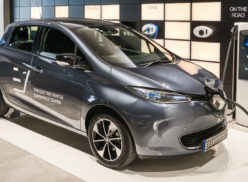On November 15, President Biden signed the bipartisan infrastructure bill into law, ensuring that upwards of a trillion dollars will be injected into roads, bridges, ports, the electric grid and many other aspects of the nation’s infrastructure in the coming years.
The law makes some significant investments in clean energy, although it is by no means at the scale of what is needed to make deep cuts to greenhouse gas emissions. For that, the much more significant Build Back Better Act needs to move forward.
BIF becomes law
The bipartisan infrastructure bill (BIF) will not be mistaken for a landmark climate bill, but it does contain some very important programs contributing to the energy transition.
The bipartisan infrastructure bill (BIF) will not be mistaken for a landmark climate bill, but it does contain some very important programs contributing to the energy transition.
The law puts $7.5 billion into electric vehicle charging infrastructure, along with $2.5 billion into electric buses. Another $65 billion goes into a historic investment in Amtrak, which could improve and extend rail service across the country.
A very significant and under-discussed aspect of the law goes to accelerating the construction of long-distance transmissions lines. Solar and wind are already the cheapest sources of new electricity generation in much of the country, but one of the largest obstacles to a faster transition this decade will be the bottlenecks on the electric grid. With a vast number of renewable energy projects waiting in a queue due to congestion on the grid, new transmission lines are vital. The new infrastructure law puts $65 billion into updating the grid, which could help build thousands of miles of new transmission lines, freeing up a ton of space for new renewable energy.
Just as substantial is the fact that the law gives added authority to the Federal Energy Regulatory Commission (FERC) to approve transmission projects, even if states object.
Another $4.5 billion goes into plugging abandoned oil and gas wells, which leak methane, a potent greenhouse gas.
The law also has pots of money for a long list of important technologies, including electric ferries, the electric battery supply chain, low emissions heavy duty electric trucks, energy storage, and more. There is also funding for R&D for many carbon-free energy technologies, including billions of dollars for carbon capture and hydrogen.
On the climate side of things, the law makes investments in climate adaptation and resilience, including tree planting, forest conservation and management to mitigate wildfires, and disaster response. Other programs go to lead pipe replacement and water infrastructure.
Despite these historic investments, there is little that the law will do directly to lower greenhouse gas emissions. Meanwhile, much of the law will funnel money into maintenance and construction of highways, airports, ports – “brown” infrastructure that, if anything, could increase or lock in emissions.
After BIF comes BBB
The substantial investments in U.S. infrastructure are small potatoes compared to the money available in the Build Back Better Act, widely viewed by climate and energy analysts as the much more important of the two pieces of legislation. To be sure, it has been whittled down to roughly $1.7 trillion, half the size of what most Democrats wanted.
The substantial investments in U.S. infrastructure are small potatoes compared to the money available in the Build Back Better Act, widely viewed by climate and energy analysts as the much more important of the two pieces of legislation.
Nevertheless, it contains $550 billion in funding for renewable energy, energy efficiency, and electrification. The money reauthorizes and extends subsidies for solar and wind, and includes bonuses to developers that pay workers higher wages and use domestic content. One underappreciated perk is that the subsidies will be direct pay, rather than a tax credit that companies access after the fact, which makes it difficult for companies without a tax liability to receive.
The bill would also reauthorize the federal $7,500 tax credit for electric vehicles, with another $4,500 for union-made cars. Notably, the sales cap would be lifted, allowing the likes of Tesla and GM to take advantage once again.
Another crucial provision would tax methane emissions from oil and gas companies. Importantly, this is not a tax on the natural gas that is extracted and delivered to customers – despite what industry lobbyists say – but a tax on methane that escapes into the atmosphere. Methane is an extremely powerful greenhouse gas, and eliminating methane is the easiest and fastest way to make progress on climate change. Methane that is leaked, or intentionally vented into the atmosphere by oil and gas drillers is a massive problem, and proponents of the fee believe it will help cut down on reckless ways. It remains to be seen if it will survive in the final bill.
An earlier version to the bill had the Clean Electricity Performance Program (CEPP), which would have rewarded utilities that increased renewable energy generation each year by more than 4 percent, and penalized utilities that installed new clean energy at a slower pace. But the program was scrapped due to the opposition from West Virginia Senator Joe Manchin.
That was one of the most important climate programs in the entire bill, but even without it, the U.S. could make achieve the bulk of the 50 percent emissions reductions by 2030 that the Biden administration has laid out – if Build Back Better is passed into law.
The Build Back Better Act is the “largest-ever investment to defeat the climate crisis,” according to Evergreen Action, a climate-focused group. “It will create millions of good jobs building the clean energy economy, advance environmental justice, and begin to reduce climate pollution at the scale and speed necessary to meet President Biden’s commitments and stave off the worst impacts of this crisis,” the group said in a statement.
On November 19, the House of Representatives passed the bill. It now awaits action in the Senate, where Democratic leadership hopes it will pass in the next few weeks.







